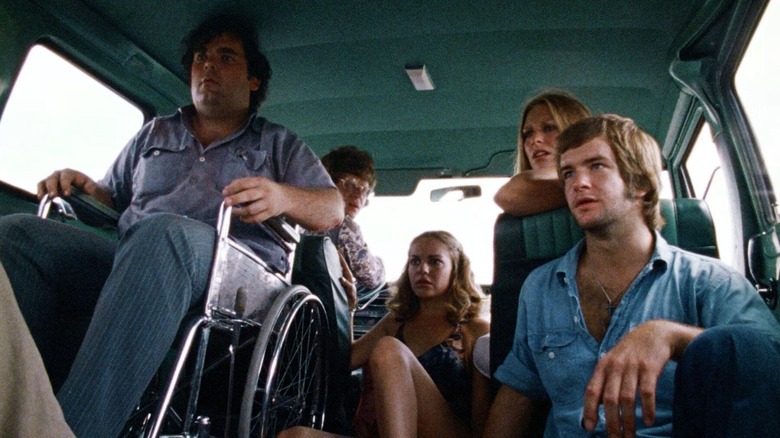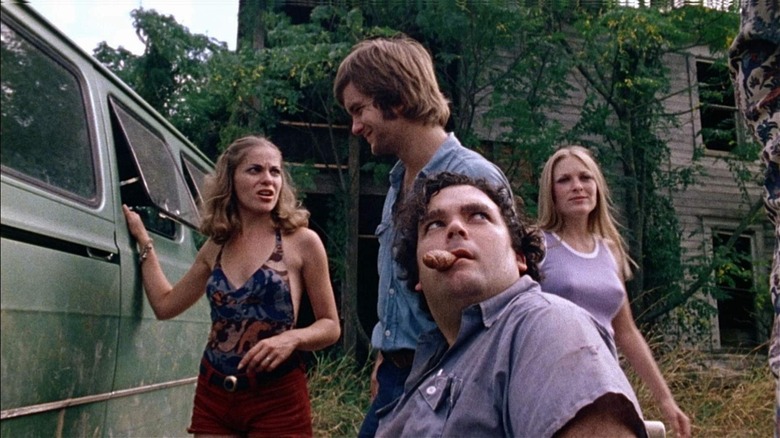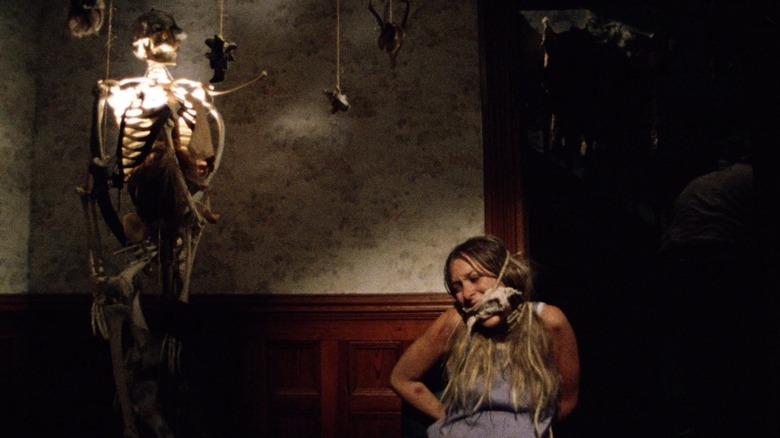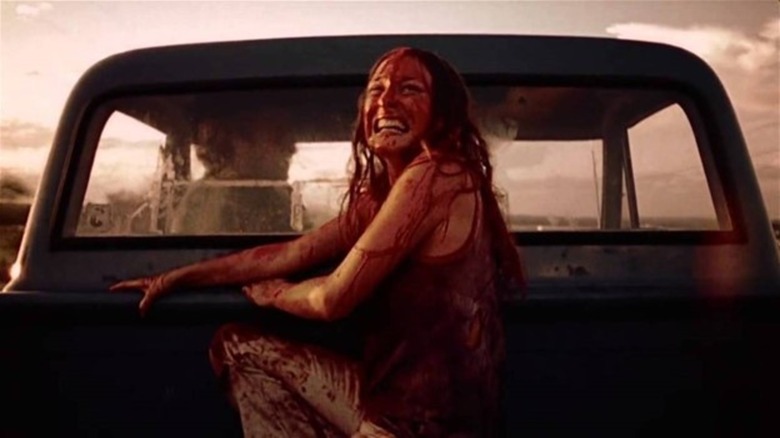The Texas Chain Saw Massacre's Shoot Made Tobe Hooper 'Hated' By The Cast And Crew
Few movies, if any at all, are more gruesome than 1974's "The Texas Chain Saw Massacre." The groundbreaking slasher flick follows Sally Hardesty (Marilyn Burns), her paraplegic brother, Franklin (Paul A. Partain), and their friends (played by Allen Danzinger, Terri McMinn, and William Vail) as they roll into the fictional town of Newt, Texas in a green camper van. Their purpose is to check the burial site of the Hardestys' grandfather amid reports of grave robbings happening in the area, but the trip takes a deadly turn when the crew picks up — and quickly kicks out — a demented hitchhiker (Edwin Neal) and makes a pitstop at the nearby old Hardesty family homestead.
It turns out that the hitchhiker is a part of a sadistic, cannibalistic family. His chainsaw-slinging brother, Leatherface (played by a masked Gunnar Hansen), brutally kills Franklin and the other friends one by one until Sally is the final girl to hunt. Here is where the "The Texas Chain Saw Massacre" distinguishes itself from subsequent horrors, such as "Halloween" and "Friday the 13th." The unhinged family subjects Sally to bondage and prolonged torture which Michael Myers and Jason Voorhees spare their victims. The sound of the chainsaw revving as Leatherface chases Sally through the dark woods doesn't just make you afraid for Sally the character, but also for Marilyn Burns the person. This was all by design.
The late Tobe Hooper co-wrote, directed, and produced the movie, drawing inspiration from real-life murderer Ed Gein. While the plot is mostly fictional, he marketed the film as based on true events and employed tactics during filming to make the movie appear as real as possible. His schemes, however, made him hated by his cast and crew.
Tobe Hooper was a master at creating real tension
"The Texas Chain Saw Massacre" was filmed in Hard Rock, Texas, not far from Austin. In a 2014 Q&A with Interview Magazine, Tobe Hooper discussed the horrific working conditions he established. He littered the set with real animal carcasses and skeletal remains. Believe it or not, some of the skeletons you see in the Leatherface family farmhouse are those of real humans. Hooper explained that it was cheaper to buy real skeletons from India than to buy plastic props (he used the real McCoy again when he directed the 1982 horror classic "Poltergeist"). He added that because more lights were needed to make a movie back, the lighting on set cooked the bones, which produced a foul odor. Hooper also said he didn't let Paul A. Partain eat lunch with the rest of the cast and bathe (his character is somewhat treated as an outcast). He further explained:
"There were ways of creating tension. Everyone in the cast and crew was synchronized, but the work was very demanding. At the end of filming, everyone hated me. It took years to reestablish those friendships but I knew what I needed to get. So all of the actors became part of this circling energy that had a lot of tension in it. And we were so isolated working on that set in Round Rock. So if this energy starts to spin fast enough, it will start to grow in the atmosphere from sky to ground. And that's what I was trying to achieve.
Out of all the people on set, it appeared that Marilyn Burns suffered the most.
Marilyn Burns took a major beating on set
Jamie Lee Curtis jumped on the scene in John Carpenter's 1978 classic, "Halloween," and became the undisputed Scream Queen. But there were actresses who paved Curtis' way to the throne — her mother, Janet Leigh, being one of them for her iconic shower scene in Alfred Hitchcock's "Psycho." Another is Marilyn Burns, who literally put her body on the line and suffered many injuries while filming "The Texas Chain Saw Massacre." In the Interview Magazine Q&A, Tobe Hooper recalled that while filming the scene in which Sally runs from Leatherface and breaks through the door of a gas station to seek help, he made her repeat the action 17 times. "And I'm not sure that we had kneepads or could afford them," Hooper said. "But Marilyn was totally into it."
In a cool plot twist — but an unfortunate one for Sally — the gas station owner (Jim Siedow) is revealed himself to be a part of the unhinged, cannibalistic family. He beats her with a broom, pins her to the floor, and hammers her with a club. In the documentary, "The Texas Chain Saw Massacre: A Family Portrait," Siedow detailed that his strikes became oh-so-real after he was prodded by the directors and even Burns herself. He explained:
"And every time we'd try it, she'd come up with a few more bruises. Finally, I got with it and started having fun doing it and started really slugging her, and we kept that up — we did eight shots — and then they finally said, 'That's a take.' She just fainted dead away. The poor girl was beaten up pretty badly.
That wasn't the end of Burns' suffering.
Marilyn Burns wasn't sure if she acting in a movie
Per the New York Post, author Joseph Lanza further detailed the horrid working conditions on the set of "The Texas Chain Saw Massacre" in his book, "The Texas Chain Saw Massacre: The Film That Terrified a Rattled Nation." After the gas station scene, the family ties Sally to a chair back at the farmhouse. Leatherface slices her finger with a knife so Grandpa (a young John Dugan in prosthetic makeup) can suck her blood. According to Lanza, Marilyn Burns suffered a real cut on her finger. The prop knife Gunnar Hansen used to cut Burns had a tube of fake blood attached to it, but for some reason, it wouldn't come out. After many takes, Hansen got fed up and sliced Burns' finger for real. Dugan unwittingly sucked her real blood ... Un-be-liev-able.
Lanza cited a later conversation between Burns and Hansen that the latter recalled in his memoir, "Chain Saw Confidential: How We Made the Most Notorious Horror Movie." Burns said to him:
"You scared me to death. I didn't know you really at all, and by this time, you're not sure if it's real or a movie. And snuff films were just coming in at this time, and I'm thinking, this is too real. The leering, leering when you started coming at me, that was really scary."
I bet hearing that would have brought a smile to Tobe Hooper's face; that's precisely the realness he aimed for. But "The Texas Chain Saw Massacre" is yet another example that life as an actor isn't always smooth sailing. Working on a movie can be as grueling and dangerous as they look on screen.



